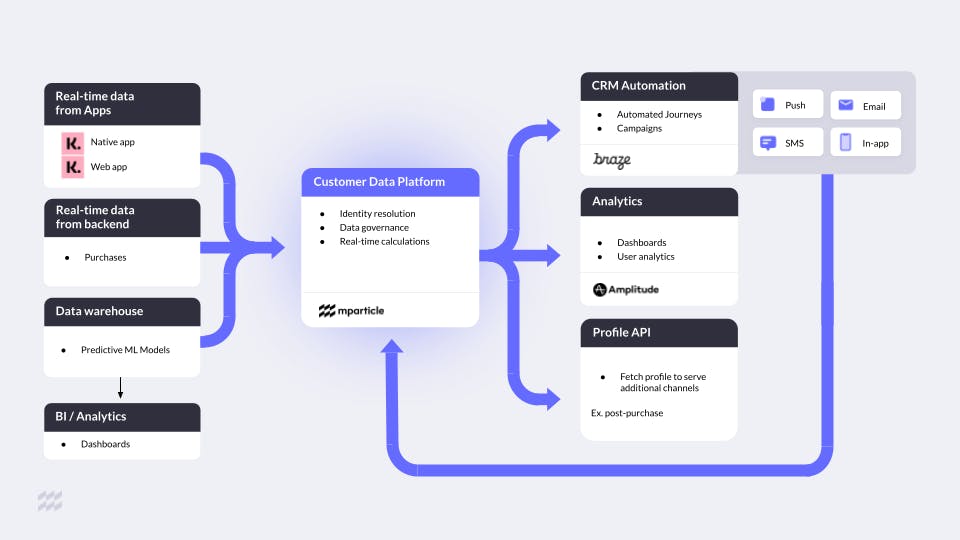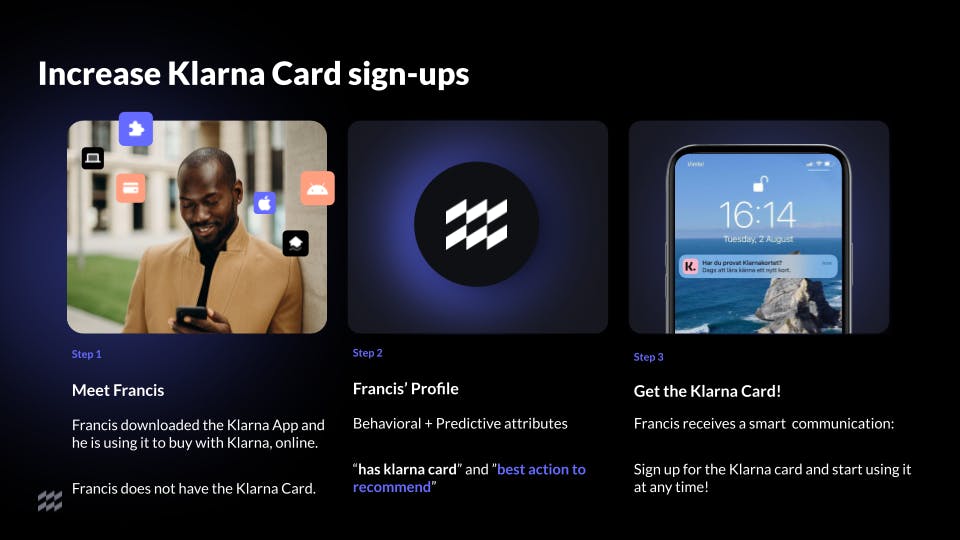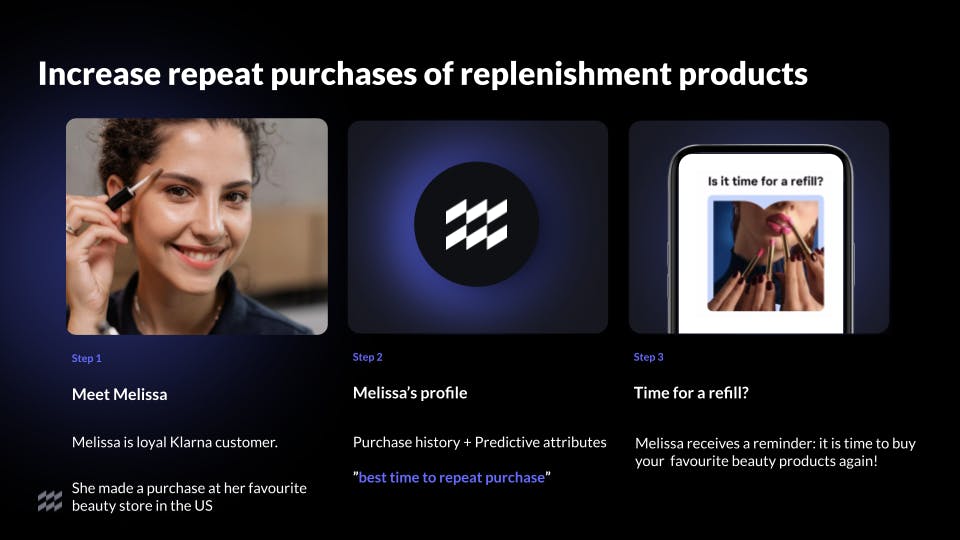How Klarna empowers 25+ teams across the organization with better customer data
In this presentation, Klarna's CRM Data team breaks down how they've partnered with mParticle to improve access to customer data and accelerate time to data value across the company.
Klarna is an ecommerce payment and smart shopping solution that aims to make online purchases simple, safe, and smooth. Today, Klarna supports 150 million active customers and 450 thousand integrated merchants, and processes over 300 billion data points each year.
To make online transactions as simple and smooth as possible, Klarna provides their users with the right offers, at the right time and on the right channel.
As Klarna’s Customer Data Platform (CDP), mParticle makes it easier to unify data from across numerous data sources to a single, high-quality view of the customer, and enables dozens of teams across the organization to leverage that data across channels for personalization.
In this presentation, Gaia Del Mauro, CRM Product Manager at Klarna, and Satrajit Basu, Engineering Manager at Klarna, discuss how Klarna utilizes mParticle to improve business results.
How is Klarna using mParticle?
Klarna powers mParticle with customer data from a variety of sources, including:
- Klarna’s native and web apps
- The cloud data warehouse
- Business Intelligence (BI) and analytics dashboards
This data flows into mParticle where identity resolution, data governance, and real-time calculations enhance the value of customer data. Data is then connected downstream to a number of marketing automation and analytics tools without engineering support.
- Braze to power automated journeys and campaigns via push, email, SMS, and in-app
- Amplitude for dashboards and user analytics
- Transactional channels via the mParticle Profile API

“We’re managing data coming from over 100 teams,” Gaia Del Mauro, CRM Product Manager for Klarna, explained. With mParticle positioned as the central system of movement for customer data, Klarna can empower marketing teams with high-quality customer data while also freeing engineering resources.
Every personalization campaign Klarna deploys relies on the accuracy and quality of the underlying data. If the data’s incorrect, or if marketing teams don’t trust it, everything breaks down. mParticle supports Klarna's data quality, relieving manual data maintenance work for engineering so that they work on more complex projects, while also allowing marketing to move faster.
The mParticle data plan helps us maintain data quality and also gives us the insight of receiving any unplanned data, which is very important for us. It gives us the control to reduce unwanted data in the CDP system and increase governance.
Engineering Manager at Klarna
Klarna’s CDP organizational structure
With customer data being collected from so many sources, and with so many teams utilizing data forwarded from mParticle, it was important for Klarna to establish clear ownership of the CDP.
The CRM Data Team owns the CDP at Klarna. The CRM Data Team works closely with app developers and backend engineers to manage data collection into the CDP, while also working closely with marketing teams to ensure they can use the data in the CDP to accomplish business objectives. As the CRM Data Team has the training and experience to handle sensitive customer data, they can establish data quality management and privacy governance to ensure all teams are working with the right data.
“Our mission is to provide a consistent data view of Klarna consumers, so that we can enable CRM teams across the company to reach out to the right user, at the right time, on the right channel—so we can create, together, a relevant and personalized shopping experience for all our customers,” Gaia said.
This setup means engineering only has to maintain and update a single data pipeline, and it empowers marketing teams across the company—working on customer activation, conversion, churn, and more—with a 360 degree view of the customer and less reliance on engineering resources.
“The main benefit for our internal customers,” Gaia shared, “is reduced time-to-market, where we don’t need to rely on development to create audiences or calculated attributes.”

Activating on personalization with mParticle
Setting up their CDP architecture and organizational structure in this way allows the Klarna team to efficiently and accurately deploy personalization programs. In their presentation, the team highlighted two key use cases driven by mParticle:
- Increasing sign-ups for the Klarna Card by targeting the right customers at the right time
- Driving repeat purchases of replenishment products by personalizing message timing on an individual basis
Increasing Klarna Card sign-ups
The Klarna team leverages internal ML models, combined with mParticle, to identify the right individual customers to target for Klarna Card messaging.
Let’s say a loyal Klarna customer uses the app frequently, but doesn’t yet have a Klarna Card. The team knows this thanks to identity resolution that happens within mParticle. No matter how, when, or where a customer interacts with Klarna, every touchpoint is connected and resolved back to a single customer profile in mParticle.
Additional attributes—including ML predictions on whether or not a customer is a good fit for the Klarna Card—are integrated into the mParticle customer profile in real-time.
“We know this information because [customer’s] profile is created and stored within mParticle, together with behavioral data, consent information, and also some predictive attributes,” Gaia noted.
Based on all that data, the customer’s profile is designated a good candidate for Klarna Card promotion.
As Gaia put it, those attributes “are telling us that [...] recommending to him to sign up for the Klarna card is the best action to recommend right now. This information is streamlined directly and in real-time to our CRM automation tools.”
That recommendation is sent in real-time to Klarna’s CRM automation tool, and a smart communication is triggered to promote Klarna Card to that customer.

Driving repeat purchases of replenishment products
Another strategic goal for Klarna is driving repeat purchases of replenishment products. The team leverages predictive models to determine the right time for engagement—down to the individual level—to encourage repeat purchases.
Here’s an example: a loyal Klarna customer makes a purchase at their favorite beauty store. The item needs to be replenished at some point—and Klarna needs to know when, so they can deliver a reminder at the right time.
But each customer, and each item, is different.
mParticle combines real-time information with the customer’s purchase history and ML predictions ingested from Klarna’s data warehouse. It takes into account the product itself, the customer’s own personal usage history, and overall usage of the product among all Klarna customers.
“It’s a layered approach,” Satrajit explained, “and, with machine-learning, we’ve achieved a lot of accuracy here. We’ve seen purchases have increased after these recommendations.”
Unifying all this information in one customer profile helps pinpoint the most accurate replenishment time frame for this individual customer, so automatic reminder messaging can be triggered at just the right time—and delivered via the customer’s preferred communication channel.

Next steps
Since Klarna launched their partnership with mParticle in 2018, they have evolved their CDP program considerably, launching real-time personalization in use cases in 2020 and data quality controls in 2021. Over the years, they’ve built a robust personalization machine with the help of mParticle—but they aren’t done yet.
Next steps for Klarna include more experimentation, Gaia Del Mauro, Klarna’s CRM Product Manager explained—specifically experimenting with Cortex, mParticle’s Artificial Intelligence (AI) engine, as a complement to Klarna’s internal ML models.


